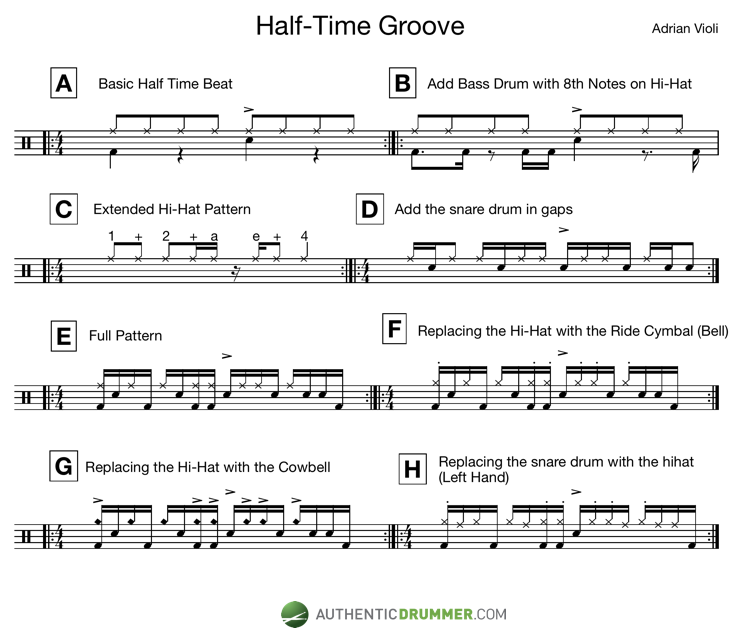
The half time groove is one of my favourites. I think the primary reason for this is that there is so much space between the groove that I can creatively ‘fill up’. The basic difference that occurs when playing a half time feel is that whilst there are still eight Hi-Hats in a normal 4/4 bar, there is only half as many back beats meaning that instead of the snare sitting on beats two and four, you end up with one big back beat on beat three alone (FIGURE A).
Now you have the opportunity to do something with all that room leading up to each back beat. This lesson is concentrating on one of the ideas I like to use for a half time feel. I use this groove quite a lot – busting it out when no one expects it such as the last chorus of the song for four bars before slamming back into the normal groove, in a solo to give contrast or in a breakdown of a song.
If I decide to get a little fancy with the groove I’ll use a 16th note subdivision. We’re going to look a break down of half time groove I use and some of the applications you may decide to do with it. First let’s look at the basic groove with eighth notes on the hi-hat (FIGURE B). Here you can see what the bass drum is going to do and how the snare falls on beat three. It’s important to give the backbeat a bit of an accent. It’s the one thing that really emphasises the shift from double time to half time. This beat in its basic form is really enough to start experimenting and would work as an application on its own.
Next comes the Hi-Hat variation. It almost has a Latin vibe but doesn’t have any accents (FIGURE C). Adding the snare drum is a fairly painless procedure by literally filling in the spaces or gaps in between the Hi-Hats. Again only accent beat 3 (FIGURE D). Now a real paradiddle influenced groove appears. In fact, beat two is half a single paradiddle and beat 3 is half an inward paradiddle (RLRR LRRL). Mixing paradiddles is a great idea for variation and done very well by masters like Steve Gadd who rules when it comes to this type of groove.
Adding the bass drum pattern to all this gives us the entire pattern (FIGURE E). From here it’s important to make it ‘groove’. It can be difficult at first to accurately play the 16th note subdivisions as ghost notes or soft. Take your time with it and use a metronome for an aid. From here the variations are plentiful (FIGURES F – H). Experiment moving your right hand to the ride cymbal, both on and off the bell and around the drums in general – cowbell etc. You could even substitute a tom or floor tom if you wanted. Another cool variation is to substitute the snare hits on to the Hi-Hat (FIGURE F). Then mix and match as much as you want.
I really dig this type of groove so have fun with it and enjoy. Oh, and check out Steve Gadd too. You won’t regret it.


Great post and explanation. I like your site. I lead a large group of drummers and musicians at a church in Mississippi. I’m going to encourage them to check it out.
I would love to see audio clips included for guys and gals that can’t read music or are very slow at it.